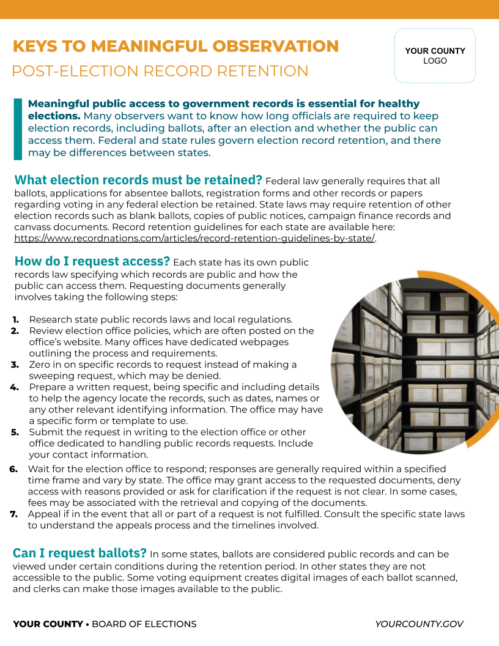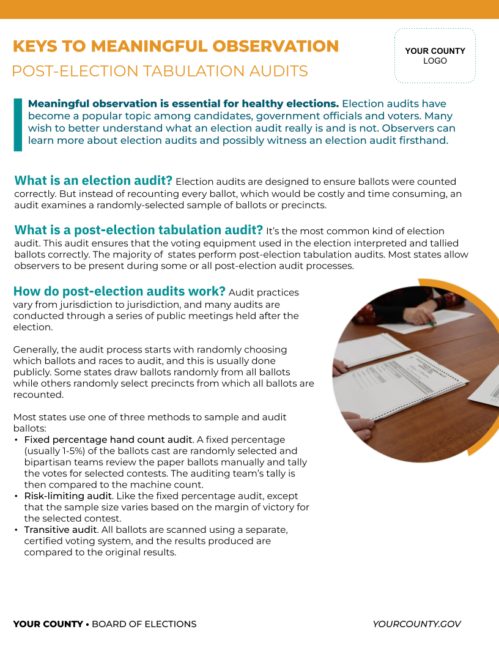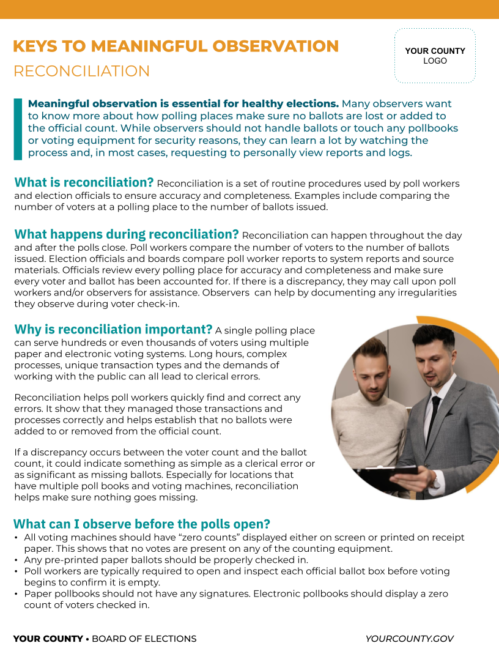February 28, 2024
Election Observer Resources
Providing for Meaningful Observation
Meaningful observation is essential to the health of the election process. Observers play an important role in validating that proper procedures were followed.
Jurisdictions can assist observers by providing information on election processes. With this information, observers can know what to expect, and they can report deviations.
Below are templates that outline election processes in a uniform way. Jurisdictions are encouraged to use and adjust the templates to fit their needs.
What Makes Observation Meaningful?
Observation is meaningful when observers make good-faith efforts to understand the election administration process and respect the rights of others, especially voters, who are participating in that process. However, meaningful observation is not just the responsibility of observers. It can only happen when election officials provide a vantage point with a comprehensive view of the election processes and their security provisions, as well as explanations that provide observers an understanding of how these provisions should interact to provide interlocking protections. The guides on this page are designed as hand-outs for election observers. These guides provide information and context that will help observers perform meaningful observation of various election processes.
Election Process Templates
Canvass

Many observers want to know more about how unofficial election results become official. Post-election canvass meetings to compile and certify the results are open to the public. Observers can also learn a lot by watching key events leading up to the final certification, including results reporting, reconciliation, and tabulation audits.
Electronic Pollbooks

In many polling places, electronic poll books are replacing printed paper poll books or rosters. Observers may have questions about this technology. While observers should not touch any equipment at a polling location or in an election office for security reasons, they can learn a lot by watching.
Election Results

Observers want to know where and how to monitor election results after the polls close. Observers can follow unofficial results from voting locations to the county clerk or board of elections office and track them online via government and media election results websites until official, certified results become available.
Mail Ballot Processing

Observers want to know where and how to observe mail ballot processing. Observers should have the opportunity to observe mail ballot receiving, intake, sorting, pre-processing and aspects of signature verification.
Mail Ballot Receiving

Many observers want to understand better how mail ballots are received. While observers should not touch any mail ballots for security reasons, they can learn a lot by watching mail ballot receiving and processing. Observers may be interested in how ballots are tracked and transported to a mail ballot processing center. A secure, transparent receiving process sets the foundation for the ensuing mail ballot validation and counting processes.
Mail Ballot Validation

Observers want to know that mail ballots were submitted validly by the qualified, registered voters who requested them. Observers may not be able to watch the entire mail ballot validation process for any given election. However, observers can learn more about the many security measures that election offices use to ensure that only validly requested and submitted mail ballots count toward an election result.
Post-Election Record Retention

Many observers want to know how long officials are required to keep election records, including ballots, after an election and whether the public can access them. Federal and state rules govern election record retention, and there may be differences between states.
Post-Election Tabulation Audits

Election audits have become a popular topic among candidates, government officials and voters. Many wish to better understand what an election audit really is and is not. Observers can learn more about election audits and possibly even witness an election audit firsthand.
Reconciliation

Many observers desire to better understand how polling places make sure no ballots are lost or added to the official count. While observers should not handle ballots or touch any poll books or voting equipment for security reasons, they can learn a lot by watching the process and in most cases even request to personally view reports and logs.
Security and Storage of Voting Equipment

Many observers desire to better understand how voting equipment is securely stored. While observers should not touch voting equipment for security reasons, they can learn a lot by watching pre-election testing of the equipment or visiting the storage facility. Observers can also learn a lot by watching election workers receive, setup, break down and stage voting equipment during early voting or on Election Day.
Understanding Who Can Vote In Person

Voter eligibility has already been determined through the registration process. Generally, any registered voter who has not already voted by mail is eligible to vote in-person. In some states voters are required to vote at their specific precinct polling place based on their residence address. In other states, voters can vote at any polling place in the county.
Voting Equipment

While observers should not touch any voting equipment for security reasons, they can learn a lot by watching pre-election testing of the equipment. Observers can also learn a lot by watching election workers use voting equipment during early voting or on Election Day.
Voter Registration List Maintenance Fact Sheet

Voter registration list maintenance is a set of routine procedures by election administrators to update, add or remove electors from the voter registration database in their jurisdiction. Election officials follow state and federal laws and rely upon official government records to verify and maintain a list of eligible voters.
Signature Verification Fact Sheet

Signature verification is a process used to confirm each voter’s identity by comparing the signature on their ballot envelope to the signature captured in their voter registration record.



